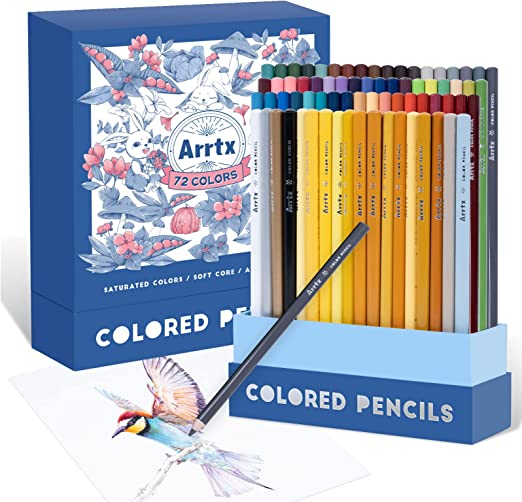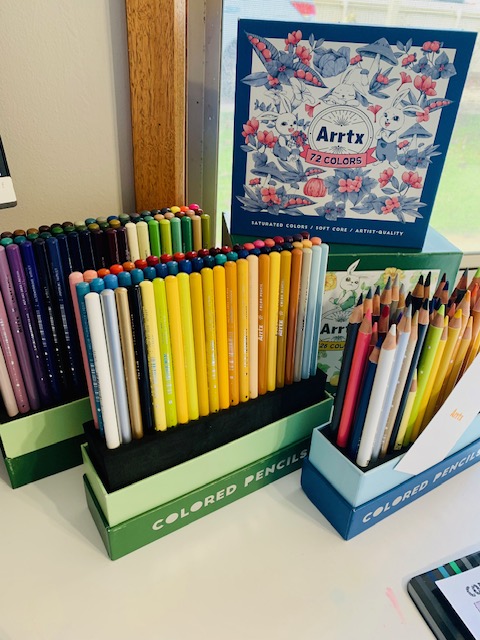Pencils - What are They Made From and Why?
Pencils - What are They Made From and Why You Should Care.
Pencils always include pigments or dyes, binder and extender and here's a break down of why.
Pigments & Dyes
Pigments and dyes provide the all important color of a colored pencil and can be made up from many different things. Commonly, pigments are either organic, that is naturally occuring, or inorganic - manmade.
"The majority of inorganic pigments are brighter and last longer than organic ones. Organic pigments made from natural sources have been used for centuries, but most pigments used today are either inorganic or synthetic organic ones. Synthetic organic pigments are derived from coal tars and other petrochemicals. Inorganic pigments are made by relatively simple chemical reactions—notably oxidation—or are found naturally as earths." (https://www.britannica.com/technology/pigment)
What You Need To Know
Pigments are often one of the more expensive components in a colored pencils and the cheaper the price of the pencil, the more likely it is to contain a lot of filler and not too much pigment.
One exception I've found - ARRTX Colored Pencils and you can read my full review of the ARRTX 126 Set HERE
Binders
In order to transfer the pigment particles to a page, a binder is added that allows for smooth application and primarily two types of binders are used; wax or oil. Now while most colored pencils contain a combination of these two binders, its the binder with the most volume that the pencil becomes known by in the modern vernacular. This means, you'll often hear artists refer to a pencil brand as 'wax based' or 'oil based.'
Oil Binders
Pencils that use oil as their binder are quite sort after on account of their smooth transfer of pigment and their 'sharpenability' The core is often stronger and dryer in this type of pencil meaning it will sharpen to a finer point, making it great for detailed work.
Some of the most popular oil based pencils are:
It's usefull to know that the oil used in oil based pencils is primarily vegetable oil.
What You Need To Know
Oil based pencils are great to use and transfer pigment to paper well. They have a harder core meaning they will sharpen to a very fine point which is great for detail. Conversely, the harder core does not blend as well as a wax pencils and requires a layering technique to achieve a smooth finish.
Wax Binders
Pencils that use a wax as a binder instantly feel different to an oil based pencils. They're softer to use and often very forgiving for a new pencil artist. They blend nicely with the right techniques and lay down pigment in a soft and vibrant way. The wax used in these pencils does vary but commonly it's a composition of Beeswax, Carnuba Wax or Parrafin.
What You Need to Know
Wax based pencils blend nicely without too much effort and for this reason are very popular amongt beginner colorists. They're also great for people with hand pain or arthritis as you dont need to use too much pressure to get a great lay down (although we shouldn't be pressing too hard anyway - but thats a conversation for another time!) For our vegan friends amongst us, check your wax pencil company carefully so you can steer clear of the pencils that use Beeswax.
Some of the more popular wax based pencils are:
 |
Prismacolor Premier Pencils |
 |
Holbein Artist Pencils |
 |
Derwent Coloursoft |
Extenders
Extenders are commonly included in pencil cores to extend the life of your pencil and to improve longevity. Commonly, manufacturers use Kaolin, Talc and or Chalk.
Kaolin is processed from kaolinite which is an industrial mineral and is used in many different processes. Things like paper, ceramics and rubber all contain laolin (an industrial mineral), has several uses in manufacturing paper, ceramics, rubber, and kaolin, as do some cosmetics. both kaolin and talc are natually available so sustainability is something that is questioned.
Chalk has the least environmental impact but is slower to process.
What You Need to Know
The more extender in the pencil core, the drier the core is so this is a consideration for your pencil selection. Typically, wax based cores have less extenders in them, leaving them with their signature blendability and creamy lay down on paper.
The term kaolin is typically used for clayey material that is low in iron content and is white or nearly white and composed of minerals of the kaolin group.
 |
| Chalk is a soft, white, porous, sedimentary carbonate rock. It is a form of limestone composed of the mineral calcite and originally formed deep under the sea by the compression of microscopic plankton that had settled to the sea floor. |
What You Need to Know
Considerations in the wood casing typically go down the environmentalist route. Companies are often quick to tell you if they use sustainable practices for wood harvesting. As an artist, the harder the wood is on your pencil, the better your pencils sharpener needs to be to give you a smooth point. Conversely, does the harder wood protect the core better? I can only recommend discussing this with the manufacturer if you're worried.
Faber Castell uses Cedar wood with two different sustainability certifications while Caran d'Ache Luminance are known for using beech wood on their premium pencils.
 |
At the Slat factory, pencil stock is cut into “Pencil Blocks” a bit longer than the normal length of a pencil. The small amount of extra length is called “trim allowance” that bears importance later on in the process. Taken from https://blog.pencils.com/pencil-making-today-2/ |
So this deep dive gives you a plethora of information about how a pencil is made and how you can made an informed decision when buying your sets. For more information I highly recommend the following blogs and sites











Comments
Post a Comment